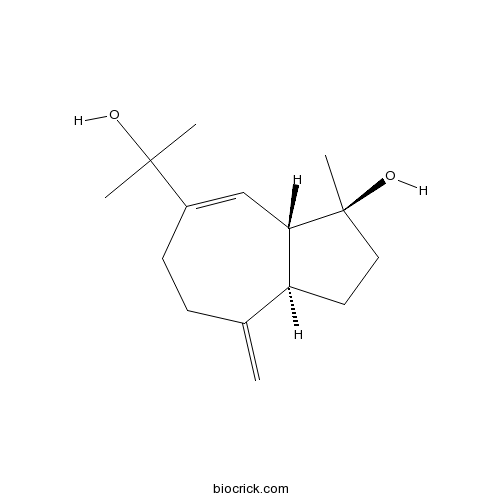4beta,12-dihydroxyguaian-6,10-dieneCAS# 461644-90-6 |

Quality Control & MSDS
3D structure
Package In Stock
Number of papers citing our products

| Cas No. | 461644-90-6 | SDF | Download SDF |
| PubChem ID | 11139125 | Appearance | Powder |
| Formula | C15H24O2 | M.Wt | 236.34 |
| Type of Compound | Monoterpenoids | Storage | Desiccate at -20°C |
| Solubility | Soluble in Chloroform,Dichloromethane,Ethyl Acetate,DMSO,Acetone,etc. | ||
| Chemical Name | (1S,3aR,8aS)-7-(2-hydroxypropan-2-yl)-1-methyl-4-methylidene-2,3,3a,5,6,8a-hexahydroazulen-1-ol | ||
| SMILES | CC1(CCC2C1C=C(CCC2=C)C(C)(C)O)O | ||
| Standard InChIKey | SYQJVLQILKBDAA-YDHLFZDLSA-N | ||
| Standard InChI | InChI=1S/C15H24O2/c1-10-5-6-11(14(2,3)16)9-13-12(10)7-8-15(13,4)17/h9,12-13,16-17H,1,5-8H2,2-4H3/t12-,13-,15-/m0/s1 | ||
| General tips | For obtaining a higher solubility , please warm the tube at 37 ℃ and shake it in the ultrasonic bath for a while.Stock solution can be stored below -20℃ for several months. We recommend that you prepare and use the solution on the same day. However, if the test schedule requires, the stock solutions can be prepared in advance, and the stock solution must be sealed and stored below -20℃. In general, the stock solution can be kept for several months. Before use, we recommend that you leave the vial at room temperature for at least an hour before opening it. |
||
| About Packaging | 1. The packaging of the product may be reversed during transportation, cause the high purity compounds to adhere to the neck or cap of the vial.Take the vail out of its packaging and shake gently until the compounds fall to the bottom of the vial. 2. For liquid products, please centrifuge at 500xg to gather the liquid to the bottom of the vial. 3. Try to avoid loss or contamination during the experiment. |
||
| Shipping Condition | Packaging according to customer requirements(5mg, 10mg, 20mg and more). Ship via FedEx, DHL, UPS, EMS or other couriers with RT, or blue ice upon request. | ||
| Description | 4beta,12-dihydroxyguaian-6,10-diene is a natural product from Alisma orientale. |
| In vitro | A new triterpenoid from Alisma orientale and their antibacterial effect.[Pubmed: 23212633 ]Arch Pharm Res. 2012 Nov;35(11):1919-26.A new triterpenoid, named alisol Q 23-acetate, as well as fourteen known terpenes, alisol B 23-acetate (2), alisol B (3), alismol (4), 10-O-methyl-alismoxide (5), alismoxide (6), 11-deoxyalisol C (7), 13β,17β-epoxyalisol B 23-acetate (8), 4beta,12-dihydroxyguaian-6,10-diene (9), alisol C 23-acetate (10), alisolide (11), 16β-methoxyalisol B monoacetate (12), alisol A (13), 16β-hydroxyalisol B 23-acetate (14), alisol A 24-acetate (15) were isolated from the rhizomes of Alisma orientale.
|

4beta,12-dihydroxyguaian-6,10-diene Dilution Calculator

4beta,12-dihydroxyguaian-6,10-diene Molarity Calculator
| 1 mg | 5 mg | 10 mg | 20 mg | 25 mg | |
| 1 mM | 4.2312 mL | 21.156 mL | 42.3119 mL | 84.6238 mL | 105.7798 mL |
| 5 mM | 0.8462 mL | 4.2312 mL | 8.4624 mL | 16.9248 mL | 21.156 mL |
| 10 mM | 0.4231 mL | 2.1156 mL | 4.2312 mL | 8.4624 mL | 10.578 mL |
| 50 mM | 0.0846 mL | 0.4231 mL | 0.8462 mL | 1.6925 mL | 2.1156 mL |
| 100 mM | 0.0423 mL | 0.2116 mL | 0.4231 mL | 0.8462 mL | 1.0578 mL |
| * Note: If you are in the process of experiment, it's necessary to make the dilution ratios of the samples. The dilution data above is only for reference. Normally, it's can get a better solubility within lower of Concentrations. | |||||

Calcutta University

University of Minnesota

University of Maryland School of Medicine

University of Illinois at Chicago

The Ohio State University

University of Zurich

Harvard University

Colorado State University

Auburn University

Yale University

Worcester Polytechnic Institute

Washington State University

Stanford University

University of Leipzig

Universidade da Beira Interior

The Institute of Cancer Research

Heidelberg University

University of Amsterdam

University of Auckland

TsingHua University

The University of Michigan

Miami University

DRURY University

Jilin University

Fudan University

Wuhan University

Sun Yat-sen University

Universite de Paris

Deemed University

Auckland University

The University of Tokyo

Korea University
- Dapagliflozin
Catalog No.:BCC2552
CAS No.:461432-26-8
- Ko 143
Catalog No.:BCC1684
CAS No.:461054-93-3
- Eact
Catalog No.:BCC6313
CAS No.:461000-66-8
- Larixyl acetate
Catalog No.:BCC8195
CAS No.:4608-49-5
- Interiotherin C
Catalog No.:BCN3636
CAS No.:460090-65-7
- Rucaparib (AG-014699,PF-01367338)
Catalog No.:BCC2207
CAS No.:459868-92-9
- 5-[(2R)-2-Aminopropyl]-2,3-dihydro-1-[3-(phenylmethoxy)propyl]-1H-indole-7-carbonitrile
Catalog No.:BCN1438
CAS No.:459868-73-6
- PEAQX
Catalog No.:BCC5495
CAS No.:459836-30-7
- Obeticholic Acid
Catalog No.:BCC5572
CAS No.:459789-99-2
- SB 452533
Catalog No.:BCC7620
CAS No.:459429-39-1
- JNJ-7777120
Catalog No.:BCC4543
CAS No.:459168-41-3
- SW033291
Catalog No.:BCC3981
CAS No.:459147-39-8
- Lactulose
Catalog No.:BCC4669
CAS No.:4618-18-2
- Gnemonol B
Catalog No.:BCN3399
CAS No.:462636-74-4
- alpha-Linolenic acid
Catalog No.:BCN8319
CAS No.:463-40-1
- Bay 55-9837
Catalog No.:BCC5932
CAS No.:463930-25-8
- (+)-Borneol
Catalog No.:BCC8376
CAS No.:464-43-7
- (-)-Borneol
Catalog No.:BCC8897
CAS No.:464-45-9
- (-)-Camphor
Catalog No.:BCN7160
CAS No.:464-48-2
- (+)-Camphor
Catalog No.:BCN7161
CAS No.:464-49-3
- Benzopinacol
Catalog No.:BCC8860
CAS No.:464-72-2
- Arenobufagin
Catalog No.:BCN5401
CAS No.:464-74-4
- Quinamine
Catalog No.:BCN6590
CAS No.:464-85-7
- Conquinamine
Catalog No.:BCN6622
CAS No.:464-86-8
A new triterpenoid from Alisma orientale and their antibacterial effect.[Pubmed:23212633]
Arch Pharm Res. 2012 Nov;35(11):1919-26.
A new triterpenoid, named alisol Q 23-acetate, as well as fourteen known terpenes, alisol B 23-acetate (2), alisol B (3), alismol (4), 10-O-methyl-alismoxide (5), alismoxide (6), 11-deoxyalisol C (7), 13beta,17beta-epoxyalisol B 23-acetate (8), 4beta,12-dihydroxyguaian-6,10-diene (9), alisol C 23-acetate (10), alisolide (11), 16beta-methoxyalisol B monoacetate (12), alisol A (13), 16beta-hydroxyalisol B 23-acetate (14), alisol A 24-acetate (15) were isolated from the rhizomes of Alisma orientale. The structures of compounds (1-15) were identified based on 1D and 2D NMR, including (1)H-(1)H COSY, HSQC, HMBC and NOESY spectroscopic analyses. Among these isolates, antibacterial effect of compounds 2, 3, 10, and 15, major constituents of A. orientale was examined. The MIC values of compounds 2, 10, and 15 were 5-10 betag/mL against eight antibiotic resistant strains, which were lower than those from the positive controls (MICs of chloramphenicol and ampicillin were 5-80 mug/mL). Therefore, compounds 2, 10 and 15 exhibited the potent antibacterial activity.


